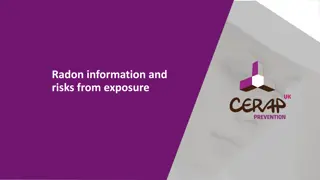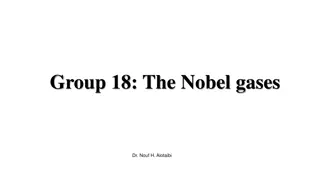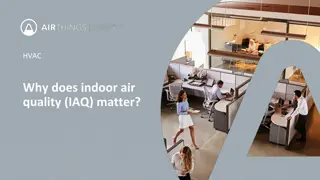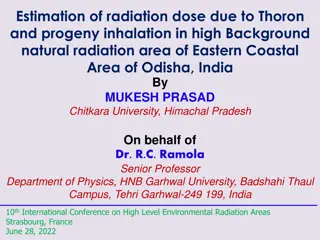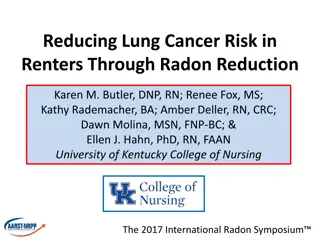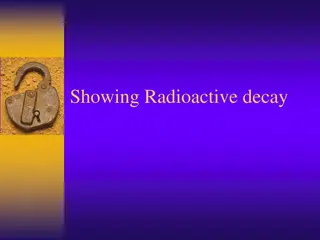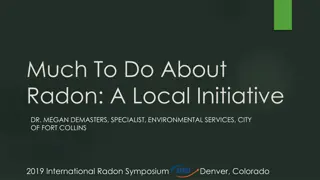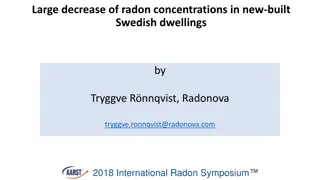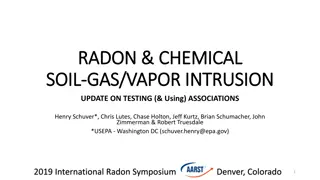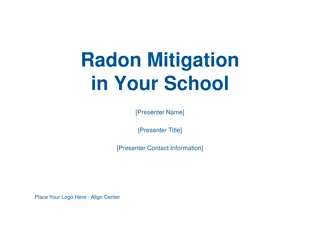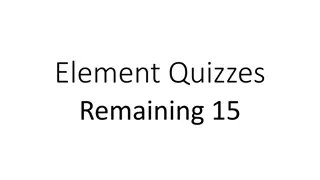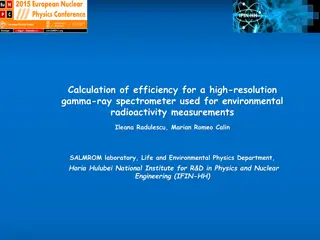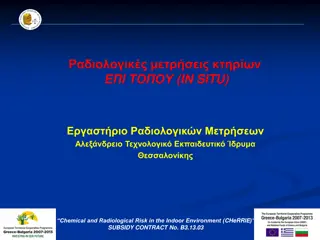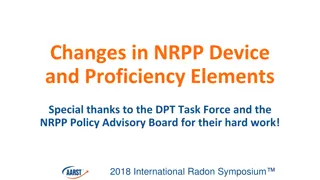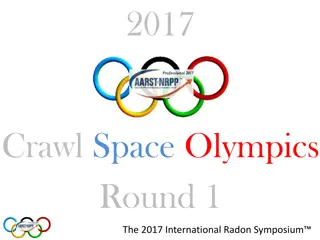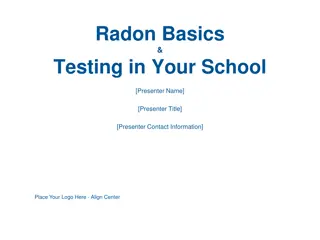Understanding Radon Exposure Risks and Prevention Measures
Radon is a colorless, odorless radioactive gas present in rocks and soils. It can enter buildings through cracks and pipes, posing health risks like lung cancer. Exposure to radon can lead to radiation damage to cells and increase the risk of cancer. It's essential to be aware of radon levels in ind
1 views • 14 slides
Understanding Radiation Pollution and Its Effects
Radiation pollution, whether ionizing or non-ionizing, is a significant environmental concern. Ionizing radiation can penetrate tissues and cause damage to living cells, while non-ionizing radiation may effectively sterilize microbes. Sources of radiation include cosmic rays, terrestrial elements li
0 views • 15 slides
The Noble Gases: Properties, Sources, and Uses
The noble gases, including helium, neon, argon, krypton, xenon, radon, and Oganesson, are characterized by their low reactivity due to a complete electron configuration. They have diverse applications, such as forming inert atmospheres, medical treatments, and lighting technologies. Naturally occurr
0 views • 16 slides
Developing and Implementing a National Radon Action Plan: Key Phases and Considerations
This learning programme by the International Atomic Energy Agency focuses on the development and implementation of a National Radon Action Plan. It covers the typical elements, timelines, and phases involved in creating such a plan, emphasizing radon reduction, prevention, and synergies with real es
0 views • 25 slides
Importance of Indoor Air Quality in HVAC Systems
Indoor air quality (IAQ) is crucial for HVAC systems as it directly impacts health, productivity, and overall well-being. Poor IAQ leads to health issues, decreased productivity, and higher absenteeism. The selection of HVAC equipment must prioritise energy efficiency, humidity control, and IAQ. The
0 views • 13 slides
Estimation of Radiation Dose Due to Thoron and Progeny Inhalation in Odisha, India
This study conducted in the Eastern Coastal Area of Odisha, India, focuses on estimating radiation doses resulting from thoron and progeny inhalation in a high natural background radiation environment. The research explores exposure to thoron, its progeny, dose conversion factors, experimental techn
0 views • 17 slides
Radon Regulation and Public Information Guidelines
This document outlines the Federal Radon Law, Indoor Radon Abatement Act, Citizen's Guide, Construction Standards, and IRAA Tech Assistance pertaining to radon regulation and public information. It emphasizes the goal of maintaining indoor air quality free of radon, provides action levels for radon
1 views • 17 slides
Addressing Lung Cancer Risk in Renters: Strategies for Radon Reduction
Lung cancer risk in renters due to radon exposure is a significant concern, especially for those in lower-income brackets. This article sheds light on the synergistic risks of radon and tobacco smoke, emphasizing the importance of reducing radon levels in rental properties to safeguard the health of
0 views • 24 slides
Understanding Radioactive Decay and Isotopes in Chemistry
Explore the fascinating world of radioactive decay, isotopes, and nuclear transformations in this educational resource. From reviewing atomic numbers to illustrating alpha and beta decay processes, discover the fundamental principles behind these phenomena with detailed explanations and visuals. Del
0 views • 17 slides
Understanding Fort Collins Radon Program: A Local Initiative
The City of Fort Collins has developed a comprehensive Radon Program focusing on community outreach, testing requirements, and communication of health risks. They offer discounted test kits, require information during real estate transactions, and aim to enhance awareness about the dangers of radon
0 views • 19 slides
Radon Concentrations in New-Built Swedish Dwellings: Findings from International Radon Symposium
Large decrease in radon concentrations observed in newly built Swedish dwellings, with data analyzed from 1950 to 2016. Dependencies between building year, foundation type, ventilation, and radon levels were evaluated. Results compared against the Swedish reference level of 200 Bq/m3. Measurements i
0 views • 14 slides
Understanding Radon and Chemical Soil Gas Vapor Intrusion
This presentation at the 2019 International Radon Symposium in Denver, Colorado explores the association between radon, chemical soil gas, and vapor intrusion. It discusses the challenges in testing, analyzing differences, and the need for supplemental measurements like radon to validate models. The
0 views • 19 slides
Colorado Legislation & Sunrise Review Process at 2019 International Radon Symposium
Overview of Colorado's Sunrise Review process, which evaluates the need to regulate previously unregulated professions. Applications for regulation must be submitted to COPRRR, with reviews based on statutory criteria. Stakeholder identification and cases of harm are emphasized for public safety and
0 views • 14 slides
Understanding Radon Mitigation in Schools
Exploring the dangers of radon exposure in schools, this presentation covers the radioactive gas's link to lung cancer, how it affects indoor spaces, and the importance of testing for radon levels. Learn about the risks of radon gas, its connection to smoking, and the measures recommended by EPA and
0 views • 21 slides
Exploring the Fascinating World of Chemical Elements Through Visuals
Dive into the captivating realm of chemical elements with this visual presentation, showcasing images and descriptions of elements like Antimony, Platinum, Silver, Radon, Strontium, Xenon, Tin, Mercury, Iodine, Tungsten, Tantalum, Barium, Gold, Lead, and Cesium. Each element is depicted in a unique
0 views • 16 slides
Efficiency Calculation of High-Resolution Gamma-Ray Spectrometer for Environmental Radioactivity Measurements
SALMROM laboratory at IFIN-HH conducts environmental radioactivity monitoring using high-resolution gamma-ray spectrometry. The system includes a Coaxial p-type HPGe detector with reliable traceability. Activities involve evaluating radon concentrations in various environments and assessing radionuc
0 views • 13 slides
Indoor Chemical and Radiological Risk Monitoring Study
The (IN.SITU) Chemical and Radiological Risk in the Indoor Environment (CHeRRIE) study conducted measurements of radon concentrations and e-perm levels in indoor environments from Oct. 2014 to March 2015. The findings show variations in radon and e-perm levels at different times of the day and acros
0 views • 14 slides
Changes in NRPP Device and Proficiency Elements: Insights from 2018 International Radon Symposium
Explore the latest updates in NRPP device requirements and proficiency elements, highlighting the importance of device-specific training for measurement professionals. The role of manufacturers/laboratories in developing training programs and the recommended course formats are discussed in detail. D
0 views • 12 slides
2017 International Radon Symposium: Crawl Space Safety Guidelines
The content discusses important safety guidelines related to working in confined spaces such as crawl spaces, attics, and pits as presented at the 2017 International Radon Symposium. Topics covered include the definition of confined spaces, permit requirements, written confined space programs, respi
0 views • 13 slides
Understanding Radon: Risks, Testing, and Prevention in Schools
Radon is a colorless, odorless, and tasteless radioactive gas that poses serious health risks, including lung cancer. This presentation covers the basics of radon, its entry into buildings, factors affecting its levels, and why it's a significant problem. Learn how to test for radon in schools and u
0 views • 28 slides
